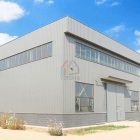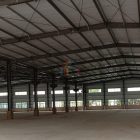Building Structural Design-Reinforcement Scheme of Steel Structure
Prestressed reinforcement steel structure scheme and construction technology:
There are two types of reinforcement schemes for steel structures. The first is the direct paste method: after anchoring and prestressing the two ends, it is pasted on the surface of the steel structure through the adhesive. It is generally suitable for tie rods with relatively flat surfaces to reinforce the components or their parts. The second is to use the bundle as a prestressed cable to adjust the stress, which is generally suitable for the overall reinforcement of the entire structure.
1. Material selection: PAN-based carbon fiber is mainly used for structural reinforcement. The ultimate strength can reach 3500MPa, and the elastic modulus is about 2.35×109MPa. The resin system adopts epoxy materials.
2. Design: According to the force characteristics, force transmission path and stress-strain field of the structure to be repaired, determine the star, size and laying direction of the cloth. The fiber direction should be as consistent as possible with the direction of maximum stress in the damaged component. If the damage site is in a complex stress state, the fiber orientation and layup sequence should be as consistent as possible with the control principal stress direction.
3. Embedded prestressed tensioning technology: The particularity of steel structure reinforcement requires a simple prestressing method. The traditional method of applying prestress is usually to first tension and then anchor, which requires relatively complex tensioning equipment and corresponding reaction force devices. When anchoring, the prestress loss is also relatively large.

The embedded prestressed tensioning technology is characterized by the fact that it is first drawn and then tensioned, and the component itself and the previous anchoring are used as the tensioning force device, without the need for complex tensioning equipment. The embedded pre-stress tensioning technology can apply pre-stress in stages, which can produce a squeezing effect on the adhesive layer and improve the reliability of the paste. At the same time, the prestress loss is small and the method is simple and effective due to the adoption of the anchoring and then tensioning technology.













